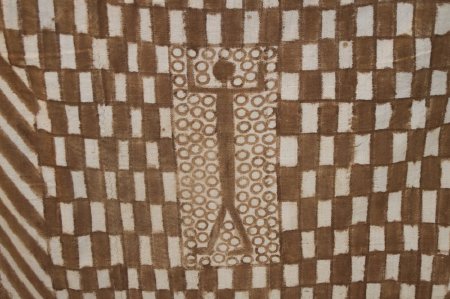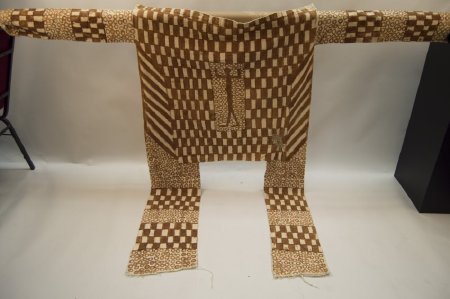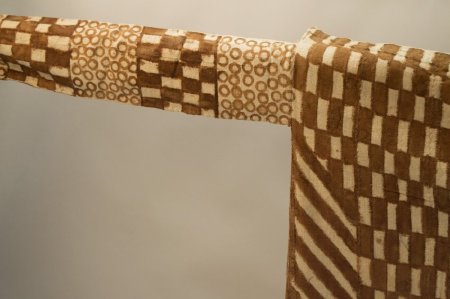Title:
Fila Mudcloth
Object Name:
Mudcloth, Fila, Cotton
Other Name:
Mudcloth
Place of Origin:
Senufo, Ghana, Africa
Provenance:
Aboriginal Indigenous Art.
L = 66—1/2"
W = 41—1/2"
The term fila is literally "dye—painted cloth," a patterned textile associated with madebele and Sando divination. When performing the masquerade, referred to as a "divination cloth masquerade" or "amulet masquerade," a Fila dancer wears the textile sack—style in a manner that recalls kafigeledjo's bodysuit. Underlying this formal affinity, the design and the symbolism of both representations are dictated by local divination systems. Fila masquerades are commissioned as part of a Sando diviner's prescription for a female client, to placate bush spirits she may have offended. She must arrange for someone to perform silently as a Fila dancer at funerals. It is impossible to say whether kafigeledjo figures influenced the costume of Fila dancers or vice versa. Whatever the origin of the imagery, to some extent they may be considered inversions of each other: one represents a wild force that has been subdued and harnessed as a means for unveiling and punishing transgressions, while the other embodies a hopeful appeal directed toward such an entity for social and spiritual harmony to be restored.
L = 66—1/2"
W = 41—1/2"
The term fila is literally "dye—painted cloth," a patterned textile associated with madebele and Sando divination. When performing the masquerade, referred to as a "divination cloth masquerade" or "amulet masquerade," a Fila dancer wears the textile sack—style in a manner that recalls kafigeledjo's bodysuit. Underlying this formal affinity, the design and the symbolism of both representations are dictated by local divination systems. Fila masquerades are commissioned as part of a Sando diviner's prescription for a female client, to placate bush spirits she may have offended. She must arrange for someone to perform silently as a Fila dancer at funerals. It is impossible to say whether kafigeledjo figures influenced the costume of Fila dancers or vice versa. Whatever the origin of the imagery, to some extent they may be considered inversions of each other: one represents a wild force that has been subdued and harnessed as a means for unveiling and punishing transgressions, while the other embodies a hopeful appeal directed toward such an entity for social and spiritual harmony to be restored.
Description:
Homespun cotton mudcloth (Fila), with mud—based dye. Tan—colored textile, with a variety of rust—colored designs and patterns.
Collection:
Marianne Keown Collection
Material:
Homespun Cotton, Mud—Based Dye
Used:
Ritually Used
Technique:
Textiles
Owned:
Art Department, Missouri Southern State University
Accession#:
2015.3.17





